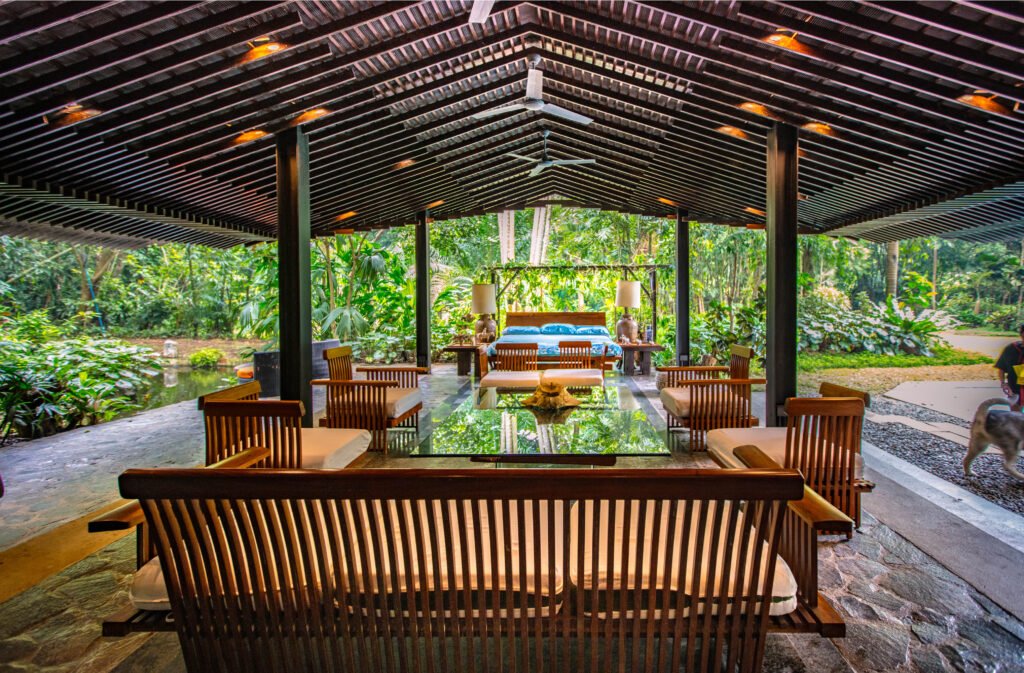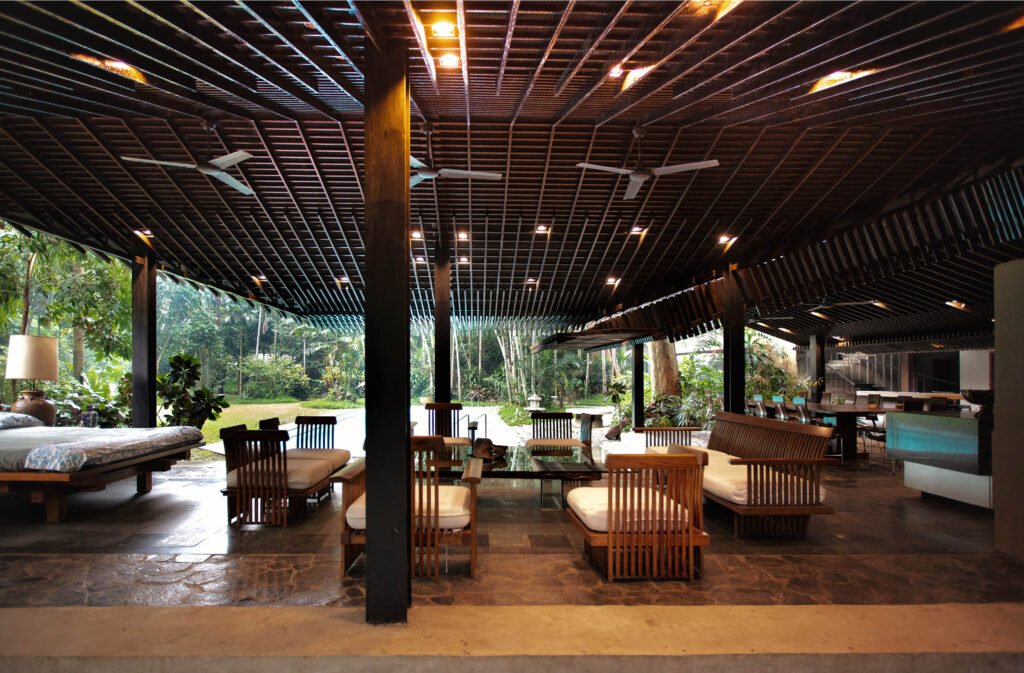Words Judith A. Torres
Images Jorge Yulo Architects Associates




Interiority is another word for psychological existence or inner life—all the trajectories of one’s consciousness, from awareness and understanding to remembrance and imagination.1 So, it makes sense that in designing interior environments for people, the spaces that resonate are those that articulate and perhaps even actualize our interiority. We see this in the powerful resonance our home has with our memories and our sense of being ourselves and at ease, compared to a strange hotel room or even a made-to-feel-like-home Airbnb.
The inclusion of Jorge Yulo’s La Cabaña de Resurección in the shortlist for INSIDE’s residential interior design category nudges us to re-examine the meaning of interiors and interiority. Why did the World Architecture Festival (WAF) organizers advise Yulo to compete in interior design rather than architecture? What did the INSIDE jury see in the wall-less poolside structure to make it a finalist? What would the INSIDE jury look for when choosing the category winner? (WAF and INSIDE category winners to be announced soon on Kanto.)
I asked these questions of interior designers Ivy Almario and Tina Periquet, WAF 2014 finalist Manny Miñana and WAF 2017 winners Andy Locsin and Sudar Khadka. The occasion was a private practice crit Kanto organized for Filipino WAF 2021 finalists and sponsored by GROHE, WAF’s founding partner since the annual festival began in 2008. The purpose of the practice crit was to anticipate the questions the WAF jurors would ask our shortlisted architects during the actual crits and provide the finalists with feedback.
Since then, I’ve come across a series of scholarly articles on interiors and interiority that have helped me appreciate even more the captivating setting Yulo created for himself and his family to play out part of their lives at their ancestral home in the province. Let’s get acquainted with the project first.


Epic love story
The original 50-year old wooden structure served as a pool house and guest cottage in a 200-year-old residential compound for a farm sugar plantation. After years of underuse and neglect, it succumbed to wood rot and termites.
The reconstructed cabana occupies the original site and footprint, between a swimming pool and a pond, amidst hundred-year-old narra and mango trees in a garden lush with mature vegetation. For reasons of cost, environment, and pest control, the new La Cabaña de Resurección is made of steel instead of wood and was left unpainted to blend in with the landscape’s mature flora. Except for the bathroom and storage, all elevations of the new structure, are without walls—Mies van der Rohe’s Farnsworth House sans glass.
The roof’s functional elements, such as sheathing, insulation, and electrical conduits, were installed inside the preexisting casing of steel slats clasped like hands at the eaves and at the junction of the two roofs. Precision in executing the roof and ceiling steel sections schedule was integral for the steel slats to hold together and form the gestural impression of the interior embracing the structure. This project, you see, is an epic love story of architecture and interior design.


The wooden furniture Yulo designed mimics the rhythm of the roof and ceiling’s repetitive modules. Translucent bathroom and powder room doors make good use of natural light. Both rooms receive a constant replenishment of fresh air from the openings above.
The new construction was more than just gentle and respectful to the preexisting natural elements of the compound. Nature has become La Cabaña’s main feature, making it the third party in a love triangle with Architecture and Interior Design.


Architecture creates interiors
To appreciate La Cabaña more fully, one must understand that before there is architecture, there is only exteriority; and there is always an interior where there is architecture. “The beginning and principle of architecture is the creation of an interior,” says Belgian architect-philosopher Bart Verschaffel. Architecture separates “a circumscribed space from its environment” and turns it into an ‘inside.’
The “first inside” from which all men emerge is the womb. This, Freud and Maslow claim, accounts for the profound need most of us have to dwell in safe and nurturing spaces.
Before architecture, proto-humans looked for naturally protected places, such as caves and corners and nooks with overhangs and canopies. When early man started building shelter, there were only three elements he needed to construct an ‘inside.’ Verschaffel discusses their anthropological meanings in his essay, The Interior as Architecture Principle.2
The first architectural element is the floor or, for primordial man, a simple ground covering—even something as humble as clean sand or fresh hay. Pre-historic men saw the floor as separating man from the underworld and its terrors beneath the soil. Later, as civilization developed, Vershaffel says man added animal hides, carpets, and tiled floors with patterns and symbols “to exorcise the dark forces that hide underneath and to organize the stage of human life.”
So strong is the instinct to separate ourselves from the bare earth and organize, we manifest it in our use of the beach towel, the picnic blanket, and the red carpet.


Second, the roof separates one’s space from the sky above. Verschaffel notes how ceiling height defines “the shape and scale of the ‘world beneath,’ where man lives.” We know from experience how vastly different one feels underneath a ceiling close to touch versus a basilica’s lofty dome. Because gazing at the ceiling means contemplating the cosmos, builders throughout history covered them too with signs and figures.
The urge to gaze at something beautiful before drifting off to sleep compels Yulo to craft one-of-a-kind ceilings. His explanation, “It’s the last thing you see at the end of the day,” resonates precisely with the thinking of builders over the ages, who crafted ceilings depicting the heavens, biblical scenes, catechism, historical and mythological personages—images to edify and inspire before slumbering or departing this world.
Third is the wall, which Verschaffel says functions differently from the first two. Floors and roofs separate man from the outside and vertically organize man’s place in the world. Walls, on the other hand, horizontally divide man’s world socially and culturally. Says Vershaffel:
“Walls divide the realms of day and night, man and woman, men and animals, the living and the dead, Communism and Capitalism, Mexico and the United States… (Walls) affirm the differences in wealth and power, assign a place to the families of the tribe, to the men and women, to the grownups and the children. And they distinguish between eating and sleeping, dirty and clean, the public and the private. The kind and materiality of a wall furthermore determine the degrees of intimacy, the conditions for what can be seen or heard publicly, and how personal life can be screened off the eyes and opinions of others.”


Essentiality and complexity
La Cabaña’s roof and ceiling, says Periquet, illustrate the difference between complexity and complicated. The design is complex because it is intricate and consists of many parts or systems, but it is not complicated, which is complex and difficult to control.
And despite seeing La Cabaña’s roof and ceiling design as “a rebuke to the minimalist style,” for Periquet, the design is essential. “I love the literal interweaving of structure, exterior finish, and interior finish. Design can be essential yet not be a blank slate. A place need not look bare for it to be minimal. Because everything that is in there is essential. Meaning, if you take anything out, it will feel something’s missing.”


Reinforcing an idea
There’s such a high degree of aesthetic quality about La Cabaña, Periquet says, that it’s almost like a sculptural composition and its occupants, participants in interactive art. Periquet asked Locsin what he thought about the bold embellishments and teased him about his alma mater’s purist modernist leanings:
“Andy, how do you feel about this unabashed ornamentation of Jorge? Because we interior designers embrace it. We see that human beings do need to personalize, decorate, and beautify; and ornament is not a crime. If this were an architectural entry, it might make some of the judges feel uncomfortable—modernist judges. The Harvard guys here might probably relate to that!”
Not all Harvardians are stark modernists, Locsin replied. “There are Harvard guys who do like Frank Lloyd Wright, who love Fay Jones, who love Charles Rennie Mackintosh, and the Arts and Crafts movement.
“This is when ornament is integral to the architecture and utility—they merge as one. It’s not about stripping away stuff but about reinforcing an idea. That’s exactly what Jorge has done.”


Interiors without walls
Contemplating the merits of interior design should go beyond looking at program flow, color choice, and furniture arrangement. For Vlad Ionescu, architecture faculty at Hasselt University in Hasselt, Belgium, one must study interiors “both as an architectural challenge and an opportunity to represent subjectivity in all its dimensions—as understanding, reflection, memory, imagination and affect.”
Ionescu says, let us read interiors as a spatial and physical representation of an interiority. This makes sense if you agree with Tina Periquet, who says interior design “is all about curating experiences.” Or, as Ionescu puts it, “building up a scenography for our subjective life—our values, emotions and thoughts.”
One cannot curate our experiences meaningfully without some understanding of our interiority. However, no designer can fully know our inner lives. For that matter, people aren’t always conscious of or honest about the values, thoughts, and memories that make up their inner being, so how fully can a designer engender and express this interiority spatially and materially?
Then there is also the designer’s and the owner’s agenda. Are they following fashion? Promoting a way of life? Challenging a way of thinking? Aspiring for something entirely alien to their lives? Or are they simply thoughtless? Despite such unknowns, Ionescu says interior design is significant because it “signals how we think of the world outside ourselves.”


Yulo’s interior as interiority
From the absence of walls, one might draw easy conclusions regarding Yulo’s beliefs on intimacy and privacy. But these should be tempered with the knowledge that La Cabaña is already a private setting for family and friends to cavort around the pool in degrees of undress. Therefore, the absence of privacy provided by walls shouldn’t be made too big of a deal.
Still, the inclusion of a king-size bed instead of a self-explanatory daybed again prompts questions from the practice crit jury about privacy at night and protection from mosquitos and other evening critters. The cabana is not a residence, so the bed is not intended for houseguests, although Yulo’s sister has spent the night there on occasion. In any case, a trellis behind the headboard is planted with creepers whose weeping branches will eventually form a curtain of green and symbolically shield the bed from the outside. In addition, hidden hooks in the ceiling allow protective netting to be hung, which, apart from keeping bugs out, offers a sense of being cocooned in a smaller, safer interior.
Rather than the absence of privacy, a more appropriate interpretation of the absence of walls might be the absence of barriers. In everyday idiom, walls have negative connotations—“we hit a wall,” “like talking to a brick wall,” “there’s a wall between us,” “up the wall,” “climbing the walls” are just a few examples. So why have walls in a structure intended for outdoor enjoyment?
As Yulo says, La Cabaña is an epic love story between Nature and her lovers, Architecture and Interior Design. Might it be an actualization of Yulo’s understanding, values, thoughts, memories, fantasies, and aspirations about his beloved vocation? Perhaps this is what resonated with the INSIDE jury and moved them to grant it finalist status. •


1 Vlad Ionescu, The Interior as Interiority, Palgrave Communications, 2018 https://www.researchgate.net/publication/324041425_The_interior_as_interiority
2 Bart Verschaffel, The Interior as Architecture Principle, Palgrave Communications, 2016 https://www.nature.com/articles/palcomms201738


7 Responses